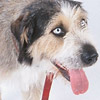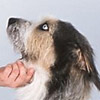Is your dog overweight? And what could that mean for him?
by Stefano Sobrero on 07/19/20
Obesity is an increasingly serious problem amongst our pets.
It wouldn’t be an overstatement to say that 40 to 50% of all the patients we see in a year can be classed as overweight. Unfortunately a lot of people find it hard to figure out what their animal’s ideal weight should be: it can be difficult to understand how just feeding 5% too much every day can eventually lead to obesity, and all the problems that come with it. Moreover there seems to be poor awareness amongst the public about the implications and consequences of obesity.
And that is probably what makes it such a common and challenging condition to deal with: the solution requires breaking habits and its seriousness is often underestimated, therefore motivation tends to be low.
I’m writing this post with the purpose of providing some information and help on the matter, hoping that it may be of benefit to you and your hairy, faithful companions.
So first of all…is your dog overweight?
Like I mentioned above, it can be difficult for some to tell. Personally I believe we’ve become so used to seeing fat animals around us that by now it seems normal to see a 40kg Labrador.
“40kg is not fat for a Labrador!” you’re probably thinking as you read this…
Trust me, there are exceptions, but yeah, generally speaking that dog would be considered overweight by a long shot!
Like I said, it can be very difficult to decide whether your pet needs to lose weight or not when there are over 100 breeds out there, with very different sizes, body shapes, hair styles, when almost half of them are way beyond their ideal BCS (body condition score) and we don’t even know it.
Wouldn’t it be great to have a standardized method to score our animal’s body condition so we can take appropriate measures without the vet telling us “your dog is fat” and making us feel bad about it?
Of course it would! And this is one of the things we’ll be talking about today.
There are mainly 3 features of your companion’s body you can use to evaluate their BCS:
- Chest: this is probably the easiest and most reliable way, and for most dogs the only one you actually need. More specifically what you want to evaluate is the rib cage, and there are two ways of doing this. If you’re looking at a short haired dog, in most cases you should be able to see (not imagine) the last 2 ribs. This can be difficult in certain breeds such as British Bulldogs and long or thick haired ones. In that case, an even more reliable way is to run your fingers (without pressing) through your dog’s chest, and feel those ribs. If they feel the same way as your knuckles do when you’re keeping your hand open, then that is fine. If they feel like your knuckles on the palm side of your hand, or if you need to apply pressure in order to feel them at all, then I’m afraid you’ve got an overweight dog. It’s as simple as that, and as long as you’re honest with yourself, you can’t get it that wrong.
- Back: place your fingers on the skin over your pet’s spine, then start moving them back and forward. You should be able to feel the vertebras under the skin you’re moving. Now, how you feel them can be very much breed related. Whippets have a much thinner skin than Staffies, therefore the feeling will be different. You should however be able to feel the spine. It doesn’t need to be excessively prominent but you shouldn’t need to apply much pressure. An overweight and/or obese dog will have fat pads accumulating along the neck, back and at base of the tail, making it harder to feel those vertebras. Fat can sometimes feel fairly solid and some may think they’re touching muscle. Which brings us to our next and last feature.
- Waistline: This one is pretty simple. Whether you have a Boxer or a Bulldog, when you look at them from above, you should be able to see their waistline. If your dog’s waist is as wide as their chest, you should seriously start thinking of getting rid of those treats. Treats (which include dental sticks by the way) and table scraps are the most common cause of obesity in our dogs, and eliminating those from their daily intake is the first and probably hardest step you’ll need to take if you want him/her to get healthy again.
So now that we’ve established a way you can monitor you dog’s body condition, there is another question that needs answering before we wrap this up: what are the consequences of excessive weight in our pets?
As for humans, there are quite a few, and some are also pretty severe and expensive to treat. So let’s take a look at some of the most common secondary diseases you CAN prevent by simply avoiding overfeeding your dog:
- heart disease and circulation problems: fat accumulates everywhere, including the heart! When this happens, the latter will start working at a pace it can’t keep up with without undergoing substantial changes, which can eventually lead to insufficiency. To make this worse, it takes much more effort for an overweight dog to move around than a normal sized one. This means that not only your dog’s heart is inefficient because of its fat accumulation, but the body is also asking for high performance all the time! That is simply not sustainable and once other vital organs start resenting of changes in the normal blood pressure, things start falling apart and they get very complicated to deal with.
- liver disease: anything we eat reaches the liver, one way or another. This complex organ has multiple functions but to keep it really simple you could see it as a huge filter for our (and our pets) blood. Any nutrients that are absorbed by the intestine and any toxins produced by the body are captured, processed and either used or eliminated by the liver. It is an amazing machine with an amazing regenerating capability but it still has its limits. Like all filters it will start piling up particles (in this case fat) if these exceed its capacity. A chronic accumulation of fat leads eventually to degeneration of the liver’s structure, which will result in malfunction. And liver malfunction means inability to eliminate toxins, which will start to accumulate in other vital organs, such as the brain. And by the time we notice the neurologic signs that come with this, it is usually late.
- arthritis:our and our pets joints were designed by mother nature to withstand a certain weight. Being constantly exposed to more than they should be baring will cause chronic inflammation which will eventually lead to arthritis. Recent studies have also shown that fat actively releases chemicals which are favorable to the inflammatory process. We unfortunately like to blame age for this disease, but the truth is, unless your dog has some form of malformation, he really shouldn’t be suffering from chronic back or hip pain at the age of 8. I very rarely see a middle age healthy dog with severe arthritis. The ones who have it are usually overweight. And yes, pain killers are a wonderful thing, but all they really do is to cover those symptoms, until they can’t any more…and at that point, again, it’s late!
- diabetes:of course diabetes can be amongst the obesity related diseases. I won’t get too technical here on why and how diabetes occurs as it would probably cause some confusion which is not the purpose of this article. Let’s just say this condition can have severe consequences on kidneys, brain, eyes, heart and skin. It pretty much messes with the entire body and if untreated it can be fatal. And once it’s there, it’s for life. There is no going back and it can be very expensive to treat! Unfortunately diabetes is also highly under-diagnosed in veterinary medicine as the symptoms can be subtle at the start. This makes the whole prognosis less favorable.
I sincerely hope this article can help you better understand whether your beloved companion needs to lose a few kg or not.
And I can’t stress this enough: if you’re struggling with it all, we are here for you. We don’t want you to feel lonely in this, we all want what is best for your pets. That is why we’ve been running FREE weight clinics for some time now. Take advantage of what we can offer!
The best day to start breaking old habits was yesterday, the next best day is today!




